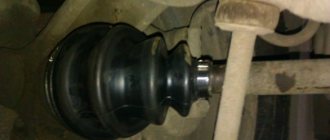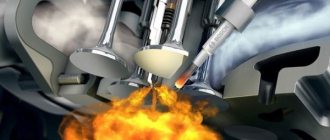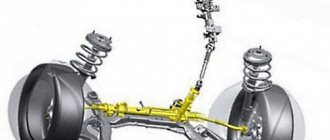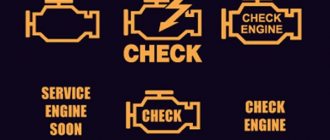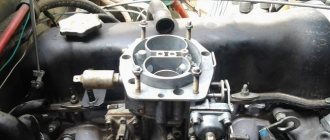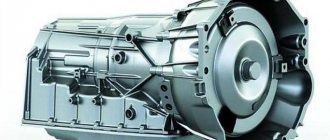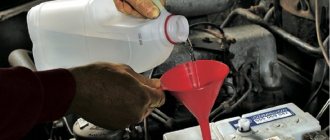What to do if the steering rack is leaking? We fix it urgently
Few car enthusiasts know what to do if the steering rack is leaking. Let's try to figure out why this happens and how to deal with it. After all, the safety of car operation directly depends on the condition of the steering. You should not hope for chance; as soon as you notice the slightest hint of a malfunction, immediately strive to eliminate it by any possible means. The simplest diagnostics can be carried out independently. Having determined the cause of the malfunction, it can be quickly eliminated without any problems in any garage. For this, no special tool is required. You can make do with what you have on hand.
Technical features
What to do if the steering rack is leaking?
To answer this question, you need to determine the technical features of this mechanism. Then it will become more clear why this happens. First, you should understand that only hydraulic racks leak. Therefore, we will look at them more carefully. Inside their cases there is a special liquid that facilitates the work of the rack, pushing it in the desired direction. The design includes a torsion bar, spool, tubes, and anthers. It is because of the latter that problems with fluid leaks from the system often occur.
Reiki diagnostics
You can determine a fluid leak by simply looking under the car after a long period of parking. If you see a puddle of dark oily liquid under the rail, then there is definitely a leak. Look under the hood, inspect all the pipes leading to the rack. If you see a leak, take steps to fix it. In most cases, the liquid supply tubes, as well as their connections, turn out to be clean.
In this case, you cannot do without an overpass. Inspecting the rack from below will help determine damage. Don't delay repairs. Dirt will likely get in through the damage. This will lead to rapid failure of the rack. Replacing it entirely can be expensive.
Debugg
In order to fix the problem, you will have to tinker. Typically, you will have to remove the rack from the vehicle to do this. Let's consider repairing such a rack. Some operations may vary on different models, mainly related to the sizes of fasteners, as well as some fasteners. But, in general, this work is done approximately the same.
But, the anthers may also leak, then the work should be continued:
- Jack up the car and remove the wheels;
- We disconnect the steering tips from the steering knuckle;
- We remove the rack from the car. Usually it is attached to 4-6 nuts, after unscrewing which you need to remove it;
- All that remains is to change the anthers. They are usually secured with retaining rings. Simply remove them using a screwdriver. When installing a new boot, be careful not to damage it.
After this, all that remains is to put the rail in place. Reinstall all parts. Don't forget to bleed the power steering system. This way you can remove any air pockets. If during the work you removed the rack, then it is worth visiting a service station to adjust the wheel alignment angles.
Conclusion
. Reiki leaking is not a rare occurrence. The peculiarities of operation affect this; on some models this is a design flaw. Therefore, drivers have a question about what to do if the steering rack is leaking. The simplest and cheapest option is to buy a rack repair kit and replace damaged parts.
Diagnosis and elimination of steering rack leaks
As a result of natural wear of the oil seals and the main shaft, steering rack leakage occurs after 120–150 thousand kilometers. Unfortunately, many motorists encounter this problem much earlier. Hence the logical question - is it possible to eliminate the problem that has arisen or is it better to immediately change the unit. Since this malfunction is not uncommon, drivers need to know what to do after it is detected.
Signs and consequences of a malfunction
A problem in the form of leaks is typical for steering racks operating in conjunction with a hydraulic power steering (power steering). Inside the unit body there are 2 oil-filled chambers with pistons that help move the shaft under the influence of pressure created by the pump. To prevent hydraulic fluid from leaking out, the sides of the chamber are sealed with oil seals, inside which the shaft moves. From the outside, the ends of the body are covered with rubber covers (anthers) in the form of accordions; the tie rod ends are passed through them.
When to pay attention to the steering rack and check for leaks:
- oil stains appear on the asphalt where the car is parked;
- the fluid level in the power steering expansion tank gradually decreases;
- the power steering pump makes a hum or other extraneous sounds (depending on the make of the car);
- The steering wheel feels heavy, as if the power steering has stopped helping the driver turn the wheels.
Since the rack body is a solid structure, drips are detected only under its ends, covered with anthers . To see them, just look under the car or into the engine compartment.
The consequences of a hydraulic fluid leak at the first stage are not fatal. After detecting leaks, you can continue driving, but only to a garage or car service center. Further operation of the vehicle without repair is permitted under two conditions:
- The steering wheel does not get “heavier”, and the power steering pump functions properly, without unnecessary noise.
- It is necessary to constantly add fluid to the power steering reservoir.
Important point! A ride like this can end badly. Once parked, a larger amount of oil will leak out of the rack, causing the hydraulic pump to fail after starting the engine. Repairing both units will cost twice as much.
Disassembly ABW.BY. Why did the steering rack leak?
Car owners are forced to visit service stations that specialize in repairing steering components for various problems, but if we talk about the steering rack, the most common reasons for calls are leaks and knocking. These are two typical faults of the rack, although, of course, this unit is capable of presenting other “surprises”.
However, the owner of a VW Golf 2000 It was the loss of fluid from the power steering reservoir that brought me to the car service center; at first, by the way, it was almost imperceptible, which is why it did not foretell big troubles. This, however, did not last long - soon the liquid began to leave the tank as if into a hole.
In any case, the car arrived at the service station with an empty power steering reservoir. The contents of the tank, which were poured under the cap before going to the service, were actually not enough for the entire trip - that’s how far the problem had progressed by the time we called for repairs.
Where the liquid went was clearly visible from the oily subframe.
True, what flowed out from under the clamps securing the dustproof covers of the rack was more reminiscent of water. This nuance promised much more serious troubles with the rack than the wear caused by years of operation and high mileage of the edges of the seals sealing the rack rod, as a result of which leaks appear.
Be that as it may, the rail must be removed and disassembled. Only disassembly will show whether it will be possible to cope with the malfunction by replacing definitely worn out oil seals or whether the situation has turned into the worst possible scenario.
Before removing the removed rack from under the car, I would like to pay attention to the right bracket of the clamp securing the rack to the car. Why? Now you'll find out.
So, the rail is pulled out, we begin to disassemble it, remove the clamp clip - and under it we find...
... a hole in the rack body. It is unlikely that its appearance can be explained by anything other than corrosion caused by dirt trapped under the clamp. This is, of course, a problem, but, unfortunately, not the main one.
The main thing is that, judging by where exactly leaks were observed from the rack when the car was driven into the inspection ditch, the problem is not damage to the body. In the end, at the very least, a clamp sealed this place. Therefore, we continue to disassemble.
We remove the anthers. The amount of water poured out of the boot cannot fail to impress someone who is not involved in repairing slats and is seeing this for the first time. I can assure you that no less dirt poured out from the opposite side of the slats, because between the anthers there is a ventilation channel through which their internal cavities communicate. This is required so that the anthers, when compressed, do not inflate and are not damaged by the air inside. But in the case under consideration, in addition to air, there was also water inside, seasoned, of course, with salt.
There is no need to explain what process is initiated by the brine. Its consequences are clearly visible on one side of the rack rod...
...and so on the other.
When turning the steering wheel, the rod moves left and right depending on where the steering wheel is turned.
Due to corrosion, ulcers form on the rod, on which, like a grater, the edges of the seals wear out.
The failure of the oil seals was the cause of fluid leakage from the steering rack and, as a result, a rapid loss of fluid from the power steering reservoir.
However, if the seals no longer hold liquid, are they able to keep water from penetrating inside the rack housing, which is the power cylinder of the power steering? Judging by what was visible inside the cylinder, water had been there too.
We remove the steering shaft worm - no comments necessary.
But what is the root of evil? The dust covers are intact - where did all that water come from? According to the specialists who were engaged in disassembly, the root cause of what happened was the discrepancy between the mounting clamps and the anthers, not in size, but in the material of both. Dust covers can be rubber or made of a material resembling plastic in elasticity. That’s what they’re called, in fact – plastic anthers. Clamps come in plastic and metal.
Plastic boots are preferable, as they have proven to be more reliable and durable, but they are demanding when it comes to tightening the clamps. Plastic clamps cannot provide high-quality tightness and sealing of hard plastic boots, therefore, for example, at a service station where disassembly was carried out, such boots are necessarily attached only to metal clamps. Rubber boots are another matter. Due to their elasticity, they can be clamped well with plastic clamps.
In the case under consideration, the boots and clamps were plastic. Water penetrated through the gaps left after tightening the clamps or that appeared during operation between the boots and steering rods. It penetrated slowly and, given the nature of the corrosion damage to the rod, slowly, gradually did its job, until the problem manifested itself with a rapidly progressing leak.
Sergey BOYARSKIKH Photos and videos by ABW.BY
We thank the service station “Avtoresursservice” for advice and assistance in organizing photography
Steering racks for any car: more than 2,700 offers from various sellers on the BAMPER.BY website
Causes of leaks
There are several common reasons why the steering rack leaks:
- The main thing is driving with torn rubber covers. Moisture penetrates through the holes and gets onto the shaft, causing corrosion. The rusty surface becomes rough and begins to rub the seal lip. The slightest gap is enough for oil to escape under pressure.
- Failure to comply with the rules for handling the hydraulic booster. Holding the steering wheel in the extreme position for a long time leads to an increase in pressure inside the chambers and squeezing of the seals. If the driver constantly repeats the mistake, oil leaks from the rack will inevitably appear.
- Adding unsuitable hydraulic fluid or other composition that destroys the rubber of the seals.
- Long-term operation without replacing fluid that accumulates debris and small chips. In this case, the oil seal leaks due to abrasion.
- Critical wear of the hinge joints of the steering tips with the shaft. Due to the dangling rod, air and moisture penetrate under the boot, causing corrosion. The process then proceeds according to the scenario described in the first paragraph.
Signs of malfunction and causes of their occurrence
Most often, oil begins to leak from the steering rack as a result of wear of the rubber seals (oil seals, cuffs, gaskets). But the cause of the malfunction may also be damage to the shaft or its corrosion, so for an accurate diagnosis you need to conduct a thorough inspection of the car at a special stand in a car service center.
The mechanism can leak under the influence of such factors:
- constant driving on curbs, potholes and potholes;
- rupture of the rubber covers (boots) covering the ends of the power steering housing - moisture enters the shaft through the holes formed, causing rust on its surface;
- Fixing the steering wheel in the extreme position for too long (more than 5 seconds) while driving;
- use of low-quality hydraulic fluid;
- the presence of foreign impurities in the oil inside the power steering (metal shavings, dirt and debris);
- parking the car for a long time with the wheels turned to the side (especially in the cold season);
- driving with worn steering joints and shaft connections;
- significant overheating of the power steering pump;
- low-quality car components.
How does the steering rack leak?
If the seals or the body of the unit are damaged, the tightness of the entire system is lost, the internal pressure is disrupted, and fluid leaks out from the steering rack.
Options for solving the problem
Before drawing any conclusions, it is necessary to get to the insides of the unit and study the degree of wear of the parts. What to do when oil leaks from the rack are detected:
- Place the car on the inspection ditch, secure it with the handbrake and remove the front wheels, placing reliable blocks.
- Using a puller, press the steering rod ball pins out of the steering knuckle eyes. First unscrew the hinge nuts.
- Remove all elements that interfere with dismantling the rail. On most passenger cars, you have to remove the battery, air filter and absorber tank.
- Turn the steering wheel all the way to lock it with a mechanical anti-theft lock. Disassemble the steering shaft to rack mount.
- Empty the power steering system and disconnect the fluid supply pipes from the unit.
- Unscrew the steering rack and remove it from the car. On some models it is attached to the body, on others - to the subframe.
Note. An experienced technician is able to perform repairs without removing the unit from the machine. But if you tackle the issue yourself, it is better to remove the rail. This makes it easier to disassemble and replace worn parts.
To get to the seals, you should pull off the rubber covers secured with retaining rings or metal clamps. After this, the reasons why the steering rack leaked become visible. What action to take depends on the technical condition of the internals:
- You are lucky if there are no traces of rust on the shaft, only streaks are visible. It is enough to replace the seals, both parts.
- The rusty shaft will have to be dismantled. Small pockets of corrosion are removed by grooving and grinding on a machine, after which repair seals are installed, the inner diameter of which is selected according to the new shaft size.
- It is better to replace a shaft that is too rusty with a new one, it will be more reliable and cheaper in the long run.
- A complete replacement of the rack is carried out after identifying critical wear of the gears, manifested by knocking while driving. An accurate diagnosis is made after disassembling the unit.
To remove the shaft, you need to unscrew the protective covers (if equipped) and the gear adjustment washer, having previously marked its position. Then both shafts are removed - the steering drive and the rack and pinion. Lastly, the polymer bushings and oil seals are carefully knocked out (held in place by retaining rings). Upon completion, the body is thoroughly washed.
Advice. Before choosing a repair method, show the removed unit to a master auto mechanic. He will determine the degree of wear of the shaft and tell you how best to proceed in your situation.
If you decide to do all the repair work yourself, then it is better to choose option No. 3 - simply change the shaft and seals. Original spare parts will last at least 100 thousand km, provided that damaged rubber covers are changed in a timely manner.
The option with grooving and grinding is less reliable - the work is performed by people and not always with high quality . After careless processing, the surface of the shaft will remain rough and will immediately begin to wear out the newly installed oil seals. The rail can leak again literally after 20-40 thousand km.
Installing the unit and assembling the car is done in the reverse order. Pay special attention to filling the system with hydraulic fluid, which should also be changed. There should be no air pockets left in it. After checking the functionality, be sure to visit a service station to adjust the camber angles of the front wheels.
How to identify a malfunction?
There are a number of “symptoms” of a rack malfunction, each of which indicates its own failure. To detect a malfunction early, you should pay attention to the following signs:
- Reduced or absent effort on the steering wheel when turning. This symptom may indicate either a lack of fluid in the hydraulic booster or wear or low tension on the belt.
- Steering angle that does not correspond to the wheel angle. This discrepancy can be caused by either incorrect adjustment or wear of the crosspiece at the steering shaft or chassis parts.
- Creaking sounds when turning. The cause of the squeak is a bend in the steering shaft. Unfortunately, such a breakdown requires the purchase of a steering rack.
- Poor return of the steering wheel to its original position. This symptom indicates the need for rack adjustment or (in a bad case) wear in the worm gear area.
- The steering wheel turns spontaneously. This is a sign that the steering rack is coming out of the distributor. This situation indicates the need to replace the rack.
- Extraneous noise when turning. Squeals when turning indicate problems with the fluid (clogging) in the reservoir or hoses. You should undergo additional examination.
- Strong vibrations at the steering wheel during turns. A symptom of problems with wheel alignment, incorrect wheel alignment.
- Knocking and vibration of the steering wheel. They talk about errors in adjustment or wear of chassis parts.
As you can see, most problems can be detected while driving if you know what signs to look for. Remember: even the slightest changes in the behavior of the steering wheel or rack are a reason to visit a service station, since any malfunction can be fatal. At the same time, most problems can be solved by simple adjustment and adjustment or by replacing some of the components and parts.
Causes of steering rack oil leaks and elimination of consequences
What to do when the steering rack leaks, why it happens and how to fix it. Most modern vehicles use power steering to make it easier to control the car while driving. Designers have developed several types of such devices. They can be:
- Hydraulic.
- Electromechanical.
- Mixed.
After some period of operation of the power steering, the owner may notice that the steering rack has leaked. If such a malfunction appears on your car, you need to fix the problem immediately. If you have the ability to handle metalwork tools and know the structure of this unit, you can fix the malfunction yourself. Before you begin to fix the problem, you should understand the reasons for the leak in this device.
What to do if there is an oil leak from the steering rack
- What to do if there is an oil leak from the steering rack
- Signs of malfunction and causes of their occurrence
- How does the steering rack leak?
- How does the car behave?
- What threatens a steering rack leak?
- Finding and fixing leaks
- Leak from power steering
- Video: Replacing the power steering pump oil seal
- The steering rack seal is leaking
- The steering rack fitting is leaking
- Oil leaks between joints
- How to eliminate without disassembling
Many motorists sooner or later encounter such a malfunction as a leak in the steering rack of the power steering system (power steering). This problem cannot be ignored, since such a leak can not only lead to the breakdown of other important parts of the car, but also jeopardizes the safety of driving the vehicle. Read on in the article about the main signs and causes of leakage from the steering rack, algorithms for finding and eliminating this malfunction, as well as the possibility of repairing the unit without overhauling it.
Why does the steering rack leak?
The operating principle of the power steering rack is based on the use of working fluid pressure, which drives the mechanism for turning the front wheels.
The hydraulic power steering pump is driven by the operating power unit of the vehicle. At the same time, it supplies oil under high pressure to the distributor, which is installed in the steering rack housing. The distributor spool device distributes the fluid flow in the desired direction to help turn the front wheels. There can be several reasons for a leak, the most common are:
- oil seal leak in the steering rack;
- significant wear of the rack;
- air entering the system;
- filling with the “wrong” working fluid;
- pump overheating.
This is not the entire list of signs of malfunction for the appearance of leaks in the system. Some drivers use various additives, which, according to their manufacturers, should improve the properties of the oil, but this is not always true. Do not allow dirt to get into the oil tank and miss the deadline for replacing the working fluid.
Driving style, and especially the condition of the road surface, also greatly influence the service life of the parts of this mechanism. If a vehicle often hits curbs with its front wheels or moves along bumpy roads, then as a result of such operation, oil leaks from the joints of the unit.
The wear of the oil seal or rack can be accelerated by the presence of tears in the protective boot. Dust gets into the cracks, which, in combination with oil, becomes an abrasive, and it accelerates the wear of the rubbing surfaces of the rack mechanism, after which oil flows in the mechanism of this unit.
The Audi steering rack is an important part of this car. Its task is to transmit the driver’s force on the steering wheel to the wheel axle. In fact, the steering rack is necessary to be able to control the car.
In modern cars, various devices are used to enhance the transmission of steering energy: electromechanical, hydraulic, mixed. Audi steering racks are usually hydraulically assisted and may begin to leak as a result of damage or wear.
Detecting a leak in the steering rack is quite simple: if a puddle or stain of dark oily liquid has formed where the car is parked under the front axle, then the rack is leaking.
What to do if you notice signs of a leak?
First of all, you need to understand: even a small malfunction of the steering rack can cause serious consequences if the problem is not addressed at the right time. After all, the quality of control of the car depends on the condition of this part, and if the rack leaks heavily, then due to loss of fluid, all control may become impossible. In addition, through the leak hole, dirt, dust and small abrasive particles can enter the hydraulic booster mechanism, which will accelerate the wear of the rack elements and lead to rapid breakdown of it and the vehicle. That is why, having discovered a leak, it is necessary to immediately begin diagnostics (determine the cause of the leak) and eliminate the problem. At the same time, repairs and diagnostics of the rack can be carried out either at technical service centers or independently.
Causes of leaks and methods of repairing the steering rack
To understand why the rack leaks, you need to consider its structure and operating principle.
So, Audi racks consist of a pump that supplies working fluid (oil) to the rack body under high pressure, and a spool that distributes the oil supply (depending on the direction of rotation, the supply will be carried out to one of the side parts of the rack). This is how the wheels of the car turn.
A leak of working fluid from the rack may indicate:
- mechanical damage to the oil seal;
- wear or damage to the rack body;
- pump overheating;
- air entering the oil;
- using low-quality or unsuitable working fluid.
How to fix?
To diagnose and replace damaged rack elements, you need to perform the following steps.
- Fixation of the steering wheel and front wheels in the forward position.
- Removing parts of the engine compartment that may interfere with the removal of the rack system.
- Completely clean the rack and its parts from dirt (you can use kerosene or gasoline).
- Thorough lubrication of fastening elements.
- Removing fastening elements.
- Draining the fluid from the tank, dismantling the conductive tubes.
- Removing the oil seal and bearing, removing the rack.
Further actions depend on the cause of the leak. You should carefully inspect the elements of the rack: if the oil seal is leaking, it must be replaced, the same applies to the rack body. If there are no visible defects in the rack parts and it is impossible to determine the cause of the leak, you should contact a service station or repair center.
In addition, when replacing the rack and its elements, it is very important that the new steering racks are of high quality and suitable for the given make of car.
The Ridge-Auto store offers a wide selection of original spare parts for various brands and models of cars. In a special catalog you will find any necessary part that is guaranteed to be of high quality and completely suit your car.
Detection of rack leaks
To identify such a malfunction you will not need expensive special equipment, computer diagnostics or other tricks. The occurrence of such a problem can be heard or seen with your own eyes. A previously inaudible sound that appears when the power steering pump is operating, oil stains under the car indicate problems with this device.
An excessively loud sound from a running pump may indicate a breakdown in this unit or insufficient oil level. Fluid stains under the car indicate leaks in the power steering system. Experts also note the fact that the use of counterfeit spare parts during repairs also accelerates the wear of parts with the appearance of leaks.
How to fix a leaking steering rack
If a leak is found in the steering rack, it needs to be repaired. You should not put off solving the problem until a later date; this will only make the problem worse. If you have a tool kit, you can fix the leak yourself. The process of repairing the steering rack will be slightly different for different car models, but the procedure is approximately the same. The algorithm for performing the work will be something like this:
- the front wheels are placed in a straight-line position, while the steering wheel is securely fixed;
- in the engine compartment, you should remove all parts that will interfere with the dismantling of the product being repaired;
- using available means, the removed mechanism is cleaned from dust and all kinds of contaminants;
- Next, all fasteners are treated with a lubricant such as WD-40 or a similar liquid. After a short period of time, the fasteners can be removed;
- It is necessary to drain the oil from the tank, then remove the supply pipes. To avoid damaging the edges of the nuts, use a special wrench that completely covers the nut;
- Before removing the cardan from the mechanism, its position is marked with marks. This will allow you to correctly install it in its place in the future;
- After this, remove the oil seal along with the ball bearing.
How to determine whether a steering rack is faulty
One of the most common malfunctions in cars is a malfunction of the steering rack, which is a device that connects the steering wheel and wheels and allows the driver to control them.
The thing is that when you turn the steering wheel, the wheels, through this unit, accurately react to which direction they should turn. In some cars, the steering rack is installed without a power amplifier, that is, the mechanism is connected directly to the wheels, as a result of which it is necessary to apply quite a lot of effort to turn the steering wheel, especially when it comes to trucks.
Nowadays, most cars have amplifiers installed on the rack, which come in two types: - power steering - an amplifier that runs on liquid; — EUR is an amplifier that runs on electricity.
Thanks to these devices, turning the steering wheel will be easier and more comfortable.
I would like to draw your attention to the fact that your safety primarily depends on this unit, since if it malfunctions, the maneuverability of the car is significantly reduced, which is especially important in city traffic. Also, the steering wheel can simply jam, which is why it is important that this system is always in working order.
Basic steering rack faults
Perhaps the main malfunctions of this mechanism include two:
- firstly, a knock on the steering rack, which can subsequently lead to the steering wheel jamming;
- secondly, a hum (pump hums) and fluid leakage.
By the way, if you have an EPS (electric power steering) on your car, then you need to know that such a device cannot leak, since there is no oil in its design, but it can knock very loudly.
Knocking in the steering rack So, a knock in this mechanism is a rather complex breakdown, which can be characterized by two types: superficial and internal.
A superficial knock may appear as a result of the fact that when the thrust boot ruptures, the tip quickly fails and begins to knock. To eliminate this damage, the tip and anthers must be replaced with new ones. The process of replacing these spare parts is relatively simple if you know what to do and how to do it correctly.
An internal knock indicates a more serious breakdown associated with the internal parts of the steering rack, which is very difficult to determine on your own. The fact is that in the event of an internal breakdown, the internal pistons and “steering” guide bushings break or become crushed, since they bear the main load.
As a result of such a breakdown, a knock appears. By the way, another reason for the appearance of noise during this breakdown may be a large amount of wear, which appeared over time due to high mileage.
In such a situation, you will face quite complex and expensive repairs, so it is best to entrust this matter to professionals.
Steering rack leak A leak in this system occurs when the rubber seals fail. This type of breakdown is typical for cars with power steering. As a rule, its strengthening occurs due to the injection of liquid into a housing with a special pump, and if the seals fail, the pressure drops, and the liquid begins to ooze and drip onto the road surface.
With this breakdown, the fluid level drops every day and it has to be added. Also, this breakdown can occur as a result of rusting of the shaft running along the seals, since due to rust they quickly fail. The shaft can “rust” due to prolonged inactivity of the vehicle.
Steering rack hum. The hum (hum) of the mechanism itself occurs when the fluid does not leave and at the same time the steering wheel is difficult to turn, so a strong “hum” is heard, indicating that the power steering pump has failed, which does not pump up the required pressure, and therefore it becomes difficult to turn more difficult.
If the above symptoms occur, first of all you need to diagnose your car.
In what cases can the steering rack fail? Since this design is directly connected to the wheels, its working condition is primarily affected by careless driving on uneven terrain. And therefore, if, while driving, you cross tram tracks, deep holes, bad roads too quickly, or simply drive sharply onto curbs, then the steering rack will fail very quickly.
It is also necessary to know that any “steering wheel” does not like sudden “starts” from a standstill, especially if the wheels are turned all the way in one direction or another.
Therefore, the main rule for extending the life of the system in working condition is to reduce the speed in front of an obstacle and slowly overcome it. The main signs of a faulty steering rack.
So, how can you determine the problem yourself?
Firstly, when driving, it became several times more difficult to turn the steering wheel than before.
Secondly, drops of an oily consistency began to appear under the car.
Thirdly, if you add liquid to a special tank every day, and sometimes the warning light comes out.
Fourthly, when driving over uneven surfaces, a strong knocking sound is heard in the front wheels or in the middle of the car in the front.
Fifthly, when you turn the steering wheel to the side, you hear a strong hum.
If you encounter such signs, you should immediately contact a car service center.
Is it worth repairing the steering rack?
Definitely worth it! After all, if you temporarily operate a car in which the rack is knocking or “leaking,” then you need to understand that sooner or later the guide elements will break completely, as a result of which the steering wheel will simply jam.
What if such a breakdown occurs at high speed? It will be scary to even think about the consequences. Therefore, first of all, this is your safety, which only you yourself should take care of.
What to choose: repair or replacement with a new rail?
Due to the fact that replacing the entire system from an official dealer costs quite a tidy sum, most car enthusiasts purchase “non-original” spare parts, which in turn are several times cheaper and, depending on the manufacturer, are of good quality, so these spare parts will last quite a long time , no less than spare parts from official dealers.
But often, especially thrifty car owners purchase cheap or refurbished spare parts, which can break down after only 3-6 months of use.
Also, if desired, you can purchase a complete repair kit, which includes all oil seals, anthers, bushings, etc.
But it is best to entrust the repair of the steering rack to a professional car service, since such replacement of spare parts requires certain experience and skills. At the same time, the quality of the purchased repair kit is of great importance.
Now you know how to determine whether the steering rack in your car is working properly.
avtomasta.ru
Operating principle of hydraulic rack control system
Comfortable driving and, most importantly, safety on the road depend on the normal operation of this unit. It must be said that the type of hydraulic steering, or more precisely with hydraulic booster, is by far the most common. The main structural elements of a hydraulic steering rack are a circuit through which the working fluid circulates, a gear shaft, a support sleeve, a special spool mechanism, a block with valves located on the steering shaft and a double-acting piston.
In general, the principle of operation is as follows. The system design includes a pump that is driven by the car engine. A rail is connected to it. When you turn the steering wheel using a torsion bar, access to the left or right cylinder opens, where oil flows under high pressure, which ensures that the car turns without any effort on the part of the driver.
Of course, the design is somewhat bulky, but even despite this fact, it is used in the vast majority of budget cars and almost all SUVs and trucks, providing reliability and ease of operation.
Additive Suprotek GUR
To restore performance and extend the life of the power steering
Causes of oil leakage from the rack
Despite the reliable design of this unit, it remains operational for about 120, maximum 150 thousand km, and often much less. And then the driver observes a low oil level, characteristic oil stains on the asphalt, or even hears extraneous noise when the pump is running. All this indicates a malfunction of the hydraulic system.
Experts call the following the most common steering rack malfunctions:
- air entering the system;
- significant wear of structural parts;
- oil seal leak, which is the most common;
- pump overheating;
- use of low-quality working fluid.
It should be noted that this is not the entire list of reasons why the rack leaks. In addition to oil seals, vulnerable parts of the design of this unit are sealing rings, sliding bushings - the so-called “back plates”, bearings and support bushings, and hydraulic barrier rings. It is these structural parts that are the most vulnerable because they are constantly exposed to high loads, which are actually the first cause of wear.
There are cases of dirt entering the system through a tank or a torn protective boot. After all, dust and dirt that get into the oil turn into a kind of abrasive for structural parts, which significantly accelerates the wear of rubbing surfaces. Many drivers miss the deadline for changing the working fluid, others use low-quality fluids from unknown manufacturers.
That’s why the question arises: the rack is leaking, what should I do?! The first desire of many drivers, especially those with little driving experience, knowing about the complexity of the design and the possible consequences of a malfunction, is to replace the entire unit. Yes, indeed, this measure will give a 100% result and confidence that such a malfunction will not happen again in the near foreseeable future. However, there is a big problem - the price of the issue. A new unit is expensive. It should be understood that the main parts of its design are highly reliable and have an increased service life, so they can serve for a long time.
The conclusion suggests itself. If a leak appears, it means restoration or repair is necessary, and certainly without the need to replace the entire unit.
A little about malfunctions and their causes
The first thing to remember: steering rack malfunctions are a problem whose solution cannot be postponed until later. Secondly, not all solutions boil down to the simple need to buy a steering rack instead of the one that is acting up: there can be many reasons for problems, as well as their solutions.
But even if the breakdown is so serious that the steering rack needs urgent replacement, this is not a reason to be upset. In special sections of websites selling used spare parts, you can find this necessary part at an affordable price.
As with many car parts, the main cause of steering rack malfunctions is its wear. In particular, the point of engagement of the gear with the gear base is the most loaded and, as a result, the most key place of the rack. It is this particular unit that is problematic: breakage, wear and crumbling of teeth - this is the list of the most common defects. The solution may be a simple repair or replacement of worn parts. In addition, problematic
The elements of the steering rack are control amplifiers (electric or hydraulic), which are also loaded. In this case, both repair and replacement of working elements are possible.
Restoration and repair procedure
There are several ways that a car owner can take in order to eliminate a power steering rack leak. The first, a complete replacement, has already been discussed. Experts question the appropriateness of this action. Although, everyone is free to spend their funds at their own discretion. You can, probably, thinking like this, and change the car itself for a new one. The next option is to drive with a leaking device and constantly replenish the working fluid to the required level. It’s a fairly common phenomenon among car enthusiasts when, for some reason, they don’t get around to making repairs. But in vain, because wasted time only further aggravates the problem.
The third option is a method that can be recommended immediately after detection of digging from under this node. We are talking about the use of special sealants.
Elimination of power steering steering rack leaks without repair work. Sealants
It is clear that over time, the most vulnerable elements of the power steering - oil seals, under the influence of high pressures, lose their properties, in particular elasticity. This leads to deformations and violations of the tightness of the system. It is impossible to replace the oil seal without removing and disassembling the unit itself. In a sense, an alternative to these complex measures that require time and money can be additives in the form of liquid agents added to working fluids.
Currently, two types of such funds are common.
The first is sealants, directly for eliminating leaks through oil seals and other seals. They contain components that penetrate rubber seals. They restore elasticity to the seals and cause a certain degree of swelling of these elements. The second type is special sealants that contain additional additives, the purpose of which is to improve the operation of the hydraulic system. Their peculiarity is the fact that, along with restoring the properties of sealing parts, they reduce friction, temperature and generally reduce the risk of malfunctions. Such products owe their additional qualities to special conditioners and other substances whose action is aimed at restoring seals and protecting rubbing parts.
Among other things, the use of sealants ensures cleaning of the channels through which the hydraulic fluid moves, the efficiency of the cleaning abilities of ATF increases, the mismatch between the servo mechanism and the steering drive is eliminated and, as a result, the service life of parts is significantly increased, the serviceability of the working fluid is extended, and the costs of repair work are reduced. After filling and the start of the sealant, leaks, as a rule, stop after 150 kilometers. A single fill is enough for 20-30 thousand kilometers. The figures indicated are not accurate and may vary depending on the specific sealant produced by a particular manufacturer.
Repair
The obvious option for eliminating leaks if sealants do not help is restorative repair. Currently, the car market offers special repair kits that can be used to eliminate leaks from the device.
These include seals and other small parts included in the design that are most often the cause of the problem. Such repair kits can be selected for any make of car. They are relatively inexpensive. With sets of sealing parts, they usually purchase sets of boots with clamps and special lubricant, in order to replace everything at once, without leaving behind old seals and dust protection, which can tear at any time.
Repair procedure
When the causes of oil leakage are identified, it is better to entrust their elimination to a specialist and carry out restoration work in a service station.
Repairs are carried out in the following order.
- The rack is dismantled from the car, for which it is hung on a lift, then the engine protection is removed, the heat-insulating plate is dismantled, the fasteners are unscrewed, it is removed from the mounts and pulled out. It should be noted that experts advise removing the device directly together with the steering rods. This allows for complete tightness when installing new boots.
- unscrewing from steering rods;
- unscrewing the bottom plug of the gear wheel;
- removing the retaining ring and knocking out the shaft;
- dismantling the lower oil seal;
- removing the pin that locks the upper oil seal;
- removing the retaining ring;
- pulling out the rail itself;
- removing the oil seal and bushing;
- removing the oil seal, plug, and then removing the spring and the clamping mechanism.
- Replacement of seals and, if necessary, damaged parts. If there is rust on the shaft, it is replaced with a new one. Experts do not recommend messing with grooving and grinding the shaft.
- Assembling the unit and installing it on the car is carried out in the reverse order.
Depending on the specific car model, the repair procedure may differ slightly, but the principle remains the same and in most cases, for high-quality repairs, disassembling the hydraulic unit is indispensable.
If you need to replace the rack
Unfortunately, some steering rack faults can only be solved by completely replacing it. This comes with many challenges, including financial ones. For many foreign cars or rare car models, purchasing a steering rack also involves a number of inconveniences regarding searching for or waiting for a new part. These problems can be easily avoided by using a catalog of shopping sites such as Ridge-Auto. These online stores offer a wide selection of used spare parts for many brands and specific car models. By ordering parts on such sites, you save not only your financial resources, but also time - thanks to the ability to find the right spare part in your region.
In addition, the quality of parts in large online stores is checked before sale. Thus, purchasing online is a guarantee of the quality of the purchased part and an opportunity to truly save.
Steering rack leakage - causes and consequences
As a rule, the steering rack begins to leak at 150,000 km. This is due to wear on the main shaft and oil seals. As for new cars, the racks can leak much earlier. The question arises: is it worth repairing the rack or purchasing a new one?
About the signs of malfunction and their consequences
Steering rack leakage is typical for a unit with power steering. Inside the rack there are two chambers with pistons, where oil under pressure enters, thereby the piston, under the influence of oil pressure, helps move the shaft in the required direction. The presence of oil seals on the sides of the rack allows you to maintain pressure. The outer end of the steering rack housing is covered by a boot on both sides, covering the tips.
How can you tell if your steering rack has started to leak?
- Fresh oil drops appeared under the car.
- The fluid level in the power steering reservoir decreases.
- When you turn the steering wheel, the power steering pump makes a hum or rustle.
- It becomes harder to turn the steering wheel.
Since the rack body is a solid structure, leaks can be detected in the area of the ends. It may be necessary to remove the steering tip boot.
Consequences of driving with a current rack
- The power steering pump will gradually wear out and heat up due to insufficient oil level.
- Frequent addition of oil to the tank will be required.
- If all the oil leaks out during a long period of parking, the power steering pump will immediately fail.
About the causes of leaks
Today there are 5 known reasons:
- Operating a vehicle with torn steering rack boots. Because of this, dirt and water gradually gets onto the rack shaft, causing corrosion. The rough surface of the rust begins to wear away the lip of the oil seal, opening up access for oil leakage.
- Incorrect operation in the form of holding the steering wheel for a long time in the extreme position, which causes an increase in pressure in the rack, where the oil tends to squeeze out the oil seal.
- Adding oil of a different classification or mismatch of oil, leading to destruction of rubber products.
- Untimely oil change in the power steering system. During operation, dirt and chips accumulate, which also destroys the seals.
- Activation of steering rods, the looseness of which leads to water and dirt entering through the boot onto the shaft. The further process is similar to the first point.
The rack can be repaired, but the cost of restoration will directly depend on how timely the fault was detected.
How to prevent such troubles?
The steering rack, like all components and assemblies, must be monitored. Once a year you need to put the car on a lift and check the hinge joints for functionality, the boots for integrity, and the oil in the power steering system for freshness.
Main symptoms of a malfunction
- knocking of the steering rack (to avoid this, you need to slow down smoothly before strong uneven roads, try not to move across the tram tracks, and if you already had to do this, then immediately slow down);
-stiff steering wheel (often the steering wheel begins to turn only in one direction, which makes the trip much more difficult, and will soon make it impossible);
-noise directly in the power steering;
-after stopping the car, oil stains remain on the asphalt in the front part of the car.
It is worth noting that external signs of a faulty steering rack can be easily confused with other faults. In most cases, you have to completely disassemble the rack to get to the bottom of the true cause of the breakdown.
If you have a domestic car, then the article Replacing the steering rack of a VAZ 2114 will be useful as a practical guide to replacing the rack with your own hands.
If all the above-described signs are present, a characteristic knocking sound when driving is the most obvious symptom of a steering rack failure. This unpleasant knocking noise intensifies when the steering wheel is turned in one direction.
With all these signs, the likelihood that the car will soon become completely undriveable also increases.
So, diagnosing the steering rack is quite easy, you just need to carry out the following actions: conduct a thorough technical inspection of the rack, observe the behavior of the steering. Such a timely inspection of the unit will facilitate its speedy repair if it is necessary.
The steering rack is leaking: what to do?
If you find that your car's steering rack is leaking, this is a major sign that your vehicle needs repairs. At a minimum, you will need to replace the anthers and cuffs.
However, replacement can only be made in case of minor damage. In some cases, the entire rack is disassembled and the integrity of the device mechanism body and its shaft is assessed. Oil seals and O-rings must also be carefully checked. If necessary, all these parts must be urgently replaced.
If the steering rack is leaking, you can carry out repairs at any time by replacing old oil seals with new ones, or purchasing new gaskets and O-rings. There should be no problem purchasing all these parts at this time.
Experts recommend using exclusively new consumables and spare parts during the repair process, the quality of which you will not doubt. Upon completion of repair work related to the steering rack, the hydraulic system is pumped.
Recommendations for the safety of the steering rack
For proper operation of the steering rack, you need to know some points. For example, in winter, it is recommended to turn the steering wheel left and right after the engine warms up. This way you can slightly warm up the oil in the power steering. It is also worth taking care of the integrity of the seals on the rack and the protection of the anthers. Even slight damage to the boot can lead to water and abrasive mud flowing into the steering rack.
